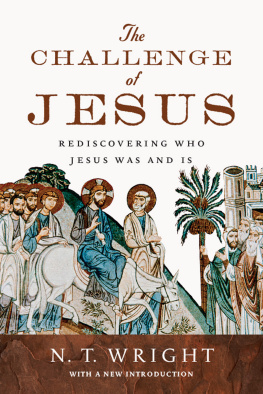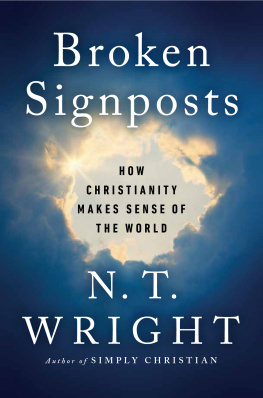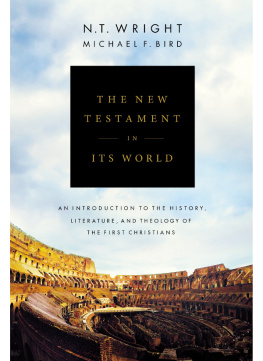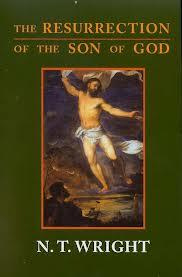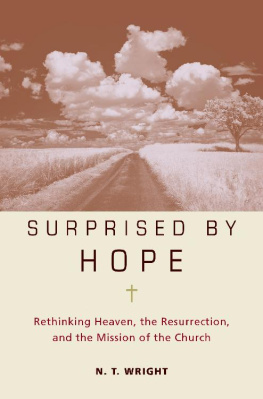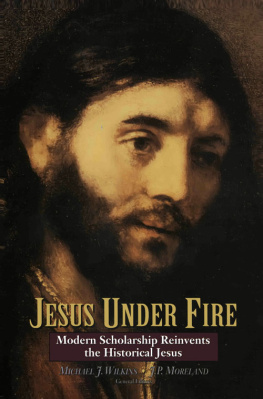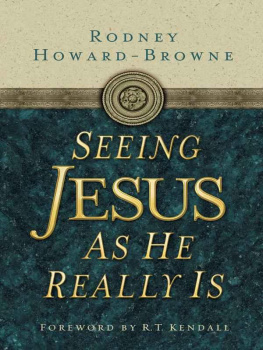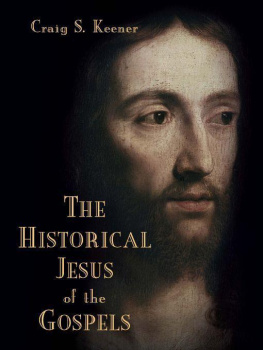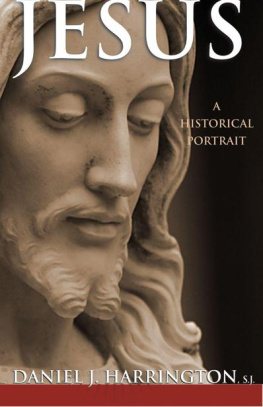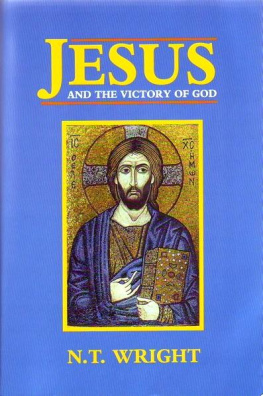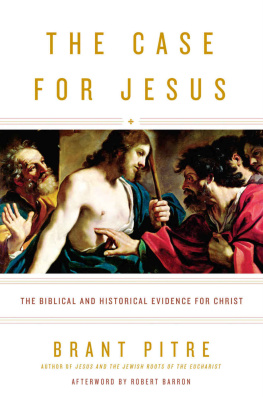For the Chapel Community at Worcester College, Oxford
Wm. B. Eerdmans Publishing Co.
2140 Oak Industrial Drive N.E., Grand Rapids, Michigan 49505 /
P.O. Box 163, Cambridge CB3 9PU U.K.
www.eerdmans.com
1992 N. T. Wright
All rights reserved
First U.K. edition published 1992 by
Society for Promoting Christian Knowledge
36 Causton Street, London SW1P 4ST
First American edition published 1993 by
Wm. B. Eerdmans Publishing Co.
New edition published 2014
Printed in the United States of America
Library of Congress Cataloging-in-Publication Data
Wright, N. T. (Nicholas Thomas) Who was Jesus? / N. T. Wright. 1st North American ed.
p. cm.
Includes bibliographical references.
ISBN 978-0-8028-7181-7
eISBN 978-1-4674-3806-3 (ePub)
eISBN 978-1-4674-0353-5 (Kindle)
1. Jesus Christ Biography History and criticism. 2. Jesus Christ Historicity. 3. Bible. N.T. Gospels Criticism, interpretation, etc.
4. Thiering, Barbara. Jesus the man. 5. Wilson, A. N., 1950 Jesus.
6. Spong, John Shelby. Born of a woman. I. Title.
BT301.9.W75 1993
232.901 dc20
[B] 93-6747
CIP
Unless otherwise noted, scripture quotations are from the New Revised Standard Version of the Bible, copyright 1989 by the Division of Christian Education of the National Council of the Churches of Christ in the U.S.A., and used by permission.
N . T . Wright
Who Was Jesus?
William B. Eerdmans Publishing Company
Grand Rapids, Michigan / Cambridge, U.K.
Contents
I n the late summer of 1992, the news media were flooded with stories about Jesus. Or rather, to be exact, stories about stories about Jesus. Amidst a storm of publicity, three books in particular stood out.
The first to hit the shelves, by a short head, was by the Australian scholar Barbara Thiering. Her Jesus the Man: A New Interpretation from the Dead Sea Scrolls claimed to be able to read between the lines of the New Testament and to discover there a quite startling picture of Jesus. In particular, she suggested that Jesus had been married, had fathered three children, and had then divorced and married again.
Shortly afterwards, the British journalist and novelist A. N. Wilson published his book, simply entitled Jesus. It was accompanied by the media equivalent of a 21-gun salute: articles and reviews in every British paper, interviews on several chat shows, and a television documentary. This book follows Wilsons recent much-publicized rejection of religion in general and of Christianity in particular.
The third similar book was by the well-known Bishop of Newark, New Jersey. John Spong has often hit the headlines through his outspoken support for radical causes. This time, in Born of a Woman, he claimed that the doctrine of the Virgin Birth had been responsible for a great deal of oppression of women, and he set out to put the record straight.
For some reason, this interest in Jesus has even reached the level of farce. The British satirical puppet show, Spitting Image, which has usually contented itself with lampooning politicians and the Royal Family, finally brought out a Jesus-puppet designed to shock and offend. And the well-known American writer Gore Vidal, in similar vein, published a scurrilous novel about the origins of Christianity, called Live from Golgotha, in which, as the editor of The Times put it, he came across like a smutty schoolboy shouting rude words across the playground.
It is important to say right from the outset that Christians do not seek a safe haven, protected from this sort of thing. Christianity takes its place in the marketplace of ideas, and is open to public scrutiny and debate. Jesus himself, on the strictly orthodox view, laid himself wide open to misunderstanding, ridicule, abuse and even death. The church has no vested interest in preventing people coming up with new ideas about Jesus. Indeed, I shall myself be arguing later on that, to this extent, the first three authors are right: the real, historical Jesus still has many surprises in store for institutional Christianity.
It is precisely for that reason that I wish to reply to these three books. They address the right issue, namely, who Jesus really was as opposed to who the church has imagined him to be. But I believe they fail to reach anything like the right answer.
How should one reply? An older generation of controversialists used to quote passage after passage and then rebut them. This is tedious, and I shall not attempt it.
Another method is to write books which clearly demonstrate better ways of looking at the whole area, so that alternative perspectives are simply outflanked. That, I hope, will be part of the effect of my longer, more scholarly works. My book The Climax of the Covenant (T. & T. Clark, 1991) sets out a way of reading Paul which, I submit, makes far more sense than Wilsons or Spongs crucial chapters on the apostle. My recent book The New Testament and the People of God (SPCK, 1992) sets out a detailed argument about the nature of history, and about first-century Judaism and early Christianity, which cuts the ground from under a good deal of all three books discussed here. In what follows (e.g. the discussions of the gospels, and of the resurrection) I shall often be drawing on this work, which is abbreviated in the notes as NTPG.
My forthcoming book Jesus and the Victory of God (SPCK, 1993) will set out a detailed and closely-argued case for a way of understanding Jesus in his historical context. This will constitute, by implication, my full positive reply to the three works here discussed; the final chapter of the present book is a tiny sketch of this longer treatment. But there I shall of course take as my conversation partners, not the recent maverick popularizers, but the serious scholarly writers in the field, particularly Vermes, Meyer, Harvey, Borg, Sanders, Horsley, Crossan and Meier.
The third way of replying to books like those of Thiering, Wilson and Spong is to show quite briefly the context of discussion in which they belong, the broad lines of their arguments, and the main reasons why they are to be discounted. That is the task of the present book. I am grateful to SPCK for taking it on, and to Andrew Goddard and David Mackinder for reading the manuscript at short notice and making several helpful comments. Though brief, I hope this work will show that it is possible to take current questions seriously and still emerge with a way of understanding Jesus that does justice both to history and to mainstream Christian belief. At the same time, I know that my own understanding of Jesus, and hence of Christianity, has been deeply and profoundly affected by my historical study. Whatever else is the case about my beliefs and my scholarship, it is certainly not true that I have found a Jesus who has merely reinforced the belief-system I had before the process began. The closer I get to Jesus within his historical context, the more I find my previous ideas, and indeed my previous self, radically subverted.
Among other beliefs, I hold more firmly than ever to the conviction that serious study of Jesus and the gospels is best done within the context of a worshipping community. I have been privileged, over the last six years, to minister to the Christian community that meets in Worcester College Chapel, Oxford. They have sustained me with their love, their enthusiasm, their criticism, and their prayers. I dedicate this book to them with much gratitude.
Michaelmas 1992 Tom Wright
The Great Revolution
Think of a Victorian drawing-room, hung with faded portraits. They stare down at you: respectable, aloof, worthy, a bit faded. The frames are heavy, gilt-edged, cracked here and there.



